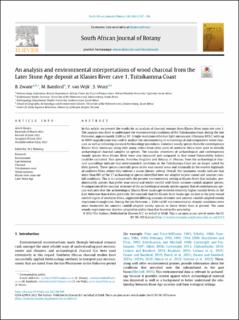| dc.contributor.author | Zwane, B. | |
| dc.contributor.author | Bamford, M. | |
| dc.contributor.author | van Wijk, Wijk | |
| dc.contributor.author | Wurz, Sarah Jacoba Deborah | |
| dc.date.accessioned | 2024-04-19T10:33:49Z | |
| dc.date.available | 2024-04-19T10:33:49Z | |
| dc.date.created | 2023-07-27T12:52:38Z | |
| dc.date.issued | 2023 | |
| dc.identifier.issn | 0254-6299 | |
| dc.identifier.uri | https://hdl.handle.net/11250/3127403 | |
| dc.description.abstract | In this article, we present the results for an analysis of charcoal remains from Klasies River main site cave 1. The analysis was done to understand the environmental conditions of the Tsitsikamma Coast during the late Holocene, approximately 2300 cal BP. A high-resolution reflective light microscope (Olympus BX51) with up to 500X magnification was used to analyse the microanatomy of archaeological and comparative wood charcoal, as well as following standard Anthracology procedures. Common woody species from the contemporary Klasies River landscape along with many others from other parts of southern Africa were used to identify archaeological charcoal samples to species. The vascular structures of archaeological and contemporary woody species from Klasies River were also measured and compared so that wood Vulnerability Indices could be calculated. Two species, Protorhus longifolia and Hibiscus cf. tiliaceus, from the archaeological charcoal assemblage indicate that environmental conditions in the Tsitsikamma Coast are no longer suited for their growth. These species currently grow in the east coastal areas and minimally in the eastern highlands of southern Africa where they tolerate a warm climatic setting. Overall, the taxonomic results indicate that more than 80% of the 17 archaeological species identified here are adapted to year-round and summer rainfall conditions. This is in contrast with the present environmental setting at Klasies River that includes, predominantly, species that prefer year-round and winter rainfall with fewer summer rainfall adapted species. A comparison of the vascular structure of the archaeological woody species against that of contemporary species indicates that the archaeological Klasies River landscape received relatively higher rainfall levels in the Late Holocene than it does presently. We conclude that the Klasies River landscape, located in the year-round rainfall region of southern Africa, supported differing amounts of winter and summer rainfall-adapted woody vegetation through time. During the late Holocene, c. 2300 cal BP, environmental or climatic conditions were more favourable for summer rainfall-adapted woody species to thrive better than at present. The same woody vegetation was also less adapted to aridity than that found in the area today. | en_US |
| dc.language.iso | eng | en_US |
| dc.publisher | Elsevier | en_US |
| dc.rights | Attribution-NonCommercial-NoDerivatives 4.0 Internasjonal | * |
| dc.rights.uri | http://creativecommons.org/licenses/by-nc-nd/4.0/deed.no | * |
| dc.title | An analysis and environmental interpretations of wood charcoal from the Later Stone Age deposit at Klasies River cave 1, Tsitsikamma Coast | en_US |
| dc.type | Journal article | en_US |
| dc.type | Peer reviewed | en_US |
| dc.description.version | publishedVersion | en_US |
| dc.rights.holder | Copyright 2023 The Author(s) | en_US |
| cristin.ispublished | true | |
| cristin.fulltext | original | |
| cristin.qualitycode | 1 | |
| dc.identifier.doi | 10.1016/j.sajb.2023.06.059 | |
| dc.identifier.cristin | 2163780 | |
| dc.source.journal | South African Journal of Botany | en_US |
| dc.source.pagenumber | 147-156 | en_US |
| dc.relation.project | Norges forskningsråd: 262618 | en_US |
| dc.identifier.citation | South African Journal of Botany. 2023, 160, 147-156. | en_US |
| dc.source.volume | 160 | en_US |

